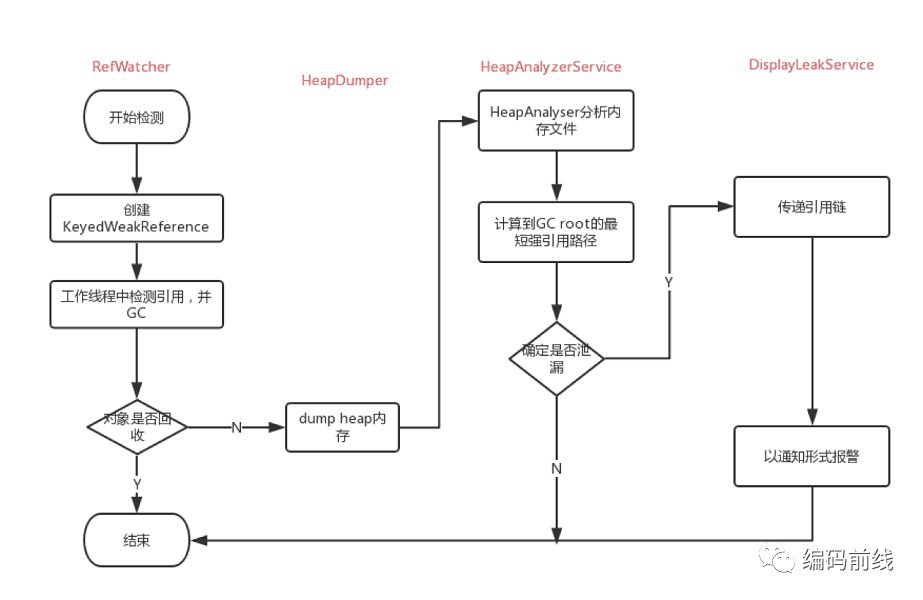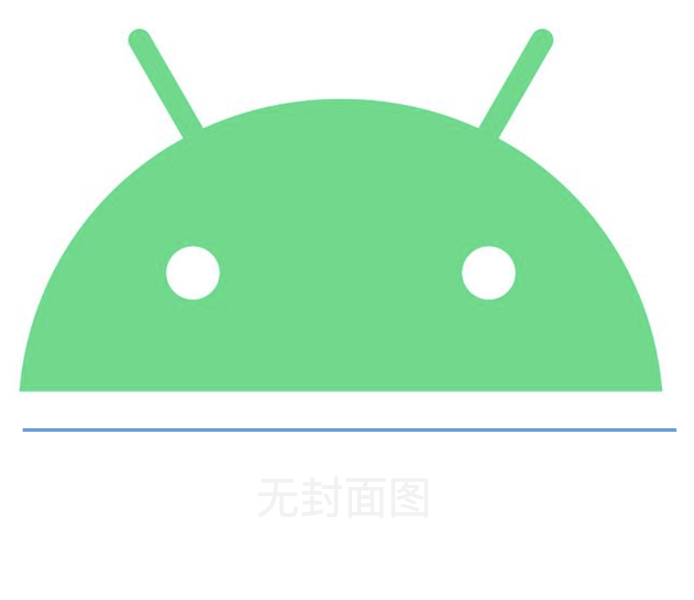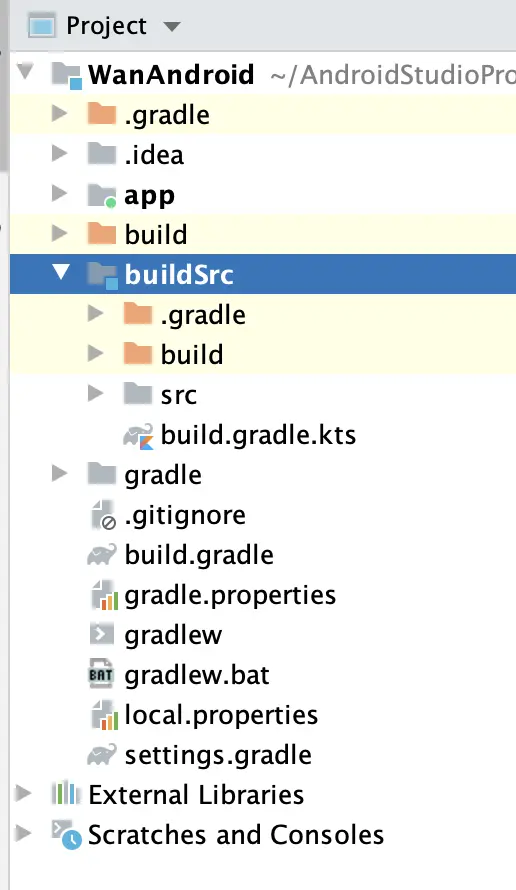概述
LeakCanary是一个开源的内存泄漏检测库,极大简化了内存泄漏的检测流程。了解其工作原理,有助于我们更好的理解Android的内存管理机制。
使用示例
在 build.gradle中添加配置:
dependencies {
debugImplementation 'com.squareup.leakcanary:leakcanary-android:1.6.3'
releaseImplementation 'com.squareup.leakcanary:leakcanary-android-no-op:1.6.3'
// Optional, if you use support library fragments:
debugImplementation 'com.squareup.leakcanary:leakcanary-support-fragment:1.6.3'
}在 Application类中添加代码:
public class ExampleApplication extends Application {
@Override
public void onCreate() {
super.onCreate();
if (LeakCanary.isInAnalyzerProcess(this)) {
// This process is dedicated to LeakCanary for heap analysis.
// You should not init your app in this process.
return;
}
LeakCanary.install(this);
// Normal app init code...
}
}使用RefWatcher观察那些本该被GC回收掉的对象:
RefWatcher refWatcher = LeakCanary.installedRefWatcher();
// We expect schrodingerCat to be gone soon (or not), let's watch it.
refWatcher.watch(schrodingerCat);工作机制
RefWatcher.watch()创建一个KeyedWeakReference到要被监控的对象。- 然后在后台线程检查引用是否被清除,如果没有,调用GC。
- 如果引用还是未被清除,把heap内存dump到APP对应的文件系统中的一个
.hprof文件中。 - 在另一个进程中的
HeapAnalyzerService有一个HeapAnalyzer使用HAHA解析这个文件。 - 在Heap Dump中,
HeapAnalyzer根据唯一的reference key找到了KeyedWeakReference,并定位了泄漏的引用。 HeapAnalyzer计算到GCRoots的最短强引用路径,并确定是否泄漏,如果是的话,建立导致泄漏的引用链。- 引用链传递到APP进程中的
DisplayLeakService,并以通知的形式展示出来。
源码分析
创建RefWatcher
public final class LeakCanary {
public static @NonNull RefWatcher install(@NonNull Application application) {
return refWatcher(application) // 创建AndroidRefWatcherBuilder对象
.listenerServiceClass(DisplayLeakService.class) // 配置监听分析结果的服务
.excludedRefs(AndroidExcludedRefs.createAppDefaults().build()) // 配置排除的系统泄露
.buildAndInstall(); // 创建一个Refwatcher并监听Activity的引用
}
// ...
}AndroidRefWatcherBuilder#buildAndInstall
public final class AndroidRefWatcherBuilder extends RefWatcherBuilder {
public @NonNull RefWatcher buildAndInstall() {
if (LeakCanaryInternals.installedRefWatcher != null) {
throw new UnsupportedOperationException("buildAndInstall() should only be called once.");
}
// 创建RefWatcher对象
RefWatcher refWatcher = build();
if (refWatcher != DISABLED) {
if (enableDisplayLeakActivity) {
LeakCanaryInternals.setEnabledAsync(context, DisplayLeakActivity.class, true);
}
if (watchActivities) {
// 监听Activity的引用
ActivityRefWatcher.install(context, refWatcher);
}
if (watchFragments) {
// 监听Fragment的引用
FragmentRefWatcher.Helper.install(context, refWatcher);
}
}
LeakCanaryInternals.installedRefWatcher = refWatcher;
return refWatcher;
}
// ...
}监听Activity的引用
ActivityRefWatcher
public final class ActivityRefWatcher {
public static void install(@NonNull Context context, @NonNull RefWatcher refWatcher) {
Application application = (Application) context.getApplicationContext();
ActivityRefWatcher activityRefWatcher = new ActivityRefWatcher(application, refWatcher);
application.registerActivityLifecycleCallbacks(activityRefWatcher.lifecycleCallbacks);
}
private final Application.ActivityLifecycleCallbacks lifecycleCallbacks = new ActivityLifecycleCallbacksAdapter() {
@Override
public void onActivityDestroyed(Activity activity) {
// 在Activity执行完onDestroyed方法时,调用RefWatcher的watch来监控该Activity是否泄露
refWatcher.watch(activity);
}
};
// ...
}检查引用
public final class RefWatcher {
public static final RefWatcher DISABLED = new RefWatcherBuilder<>().build();
// 线程控制器,在 onDestroy() 之后并且主线程空闲时执行内存泄漏检测
private final WatchExecutor watchExecutor;
// 判断是否处于调试模式,调试模式中不会进行内存泄漏检测,因为在调试过程中可能会保留上一个引用从而导致错误信息上报。
private final DebuggerControl debuggerControl;
// 用于主动触发GC操作
private final GcTrigger gcTrigger;
// 堆信息转储者,dump 内存泄漏处的 heap 信息到 hprof 文件
private final HeapDumper heapDumper;
private final HeapDump.Listener heapdumpListener;
private final HeapDump.Builder heapDumpBuilder;
// 保存每个被检测对象所对应的唯一key
private final Set retainedKeys;
// 引用队列,和WeakReference配合使用,当弱引用所引用的对象被GC回收,该弱引用就会被加入到这个队列
private final ReferenceQueueDump Heap
AndroidHeapDumper是HeapDumper的实现类。
public final class AndroidHeapDumper implements HeapDumper {
@Override @Nullable
public File dumpHeap() {
File heapDumpFile = leakDirectoryProvider.newHeapDumpFile();
if (heapDumpFile == RETRY_LATER) {
return RETRY_LATER;
}
// ...
try {
// 生成.hprof文件
Debug.dumpHprofData(heapDumpFile.getAbsolutePath());
cancelToast(toast);
notificationManager.cancel(notificationId);
return heapDumpFile;
} catch (Exception e) {
CanaryLog.d(e, "Could not dump heap");
// Abort heap dump
return RETRY_LATER;
}
}
// ...
}解析hprof
public final class ServiceHeapDumpListener implements HeapDump.Listener {
// ...
@Override
public void analyze(@NonNull HeapDump heapDump) {
checkNotNull(heapDump, "heapDump");
// 启动HeapAnalyzerServiceService来分析heapDump
HeapAnalyzerService.runAnalysis(context, heapDump, listenerServiceClass);
}
}public final class HeapAnalyzerService extends ForegroundService implements AnalyzerProgressListener {
// ...
public static void runAnalysis(Context context, HeapDump heapDump, Class extends AbstractAnalysisResultService> listenerServiceClass) {
setEnabledBlocking(context, HeapAnalyzerService.class, true);
setEnabledBlocking(context, listenerServiceClass, true);
Intent intent = new Intent(context, HeapAnalyzerService.class);
intent.putExtra(LISTENER_CLASS_EXTRA, listenerServiceClass.getName());
intent.putExtra(HEAPDUMP_EXTRA, heapDump);
ContextCompat.startForegroundService(context, intent);
}
@Override
protected void onHandleIntentInForeground(@Nullable Intent intent) {
if (intent == null) {
CanaryLog.d("HeapAnalyzerService received a null intent, ignoring.");
return;
}
String listenerClassName = intent.getStringExtra(LISTENER_CLASS_EXTRA);
HeapDump heapDump = (HeapDump) intent.getSerializableExtra(HEAPDUMP_EXTRA);
HeapAnalyzer heapAnalyzer = new HeapAnalyzer(heapDump.excludedRefs, this, heapDump.reachabilityInspectorClasses);
// 分析内存泄露的地方
AnalysisResult result = heapAnalyzer.checkForLeak(heapDump.heapDumpFile, heapDump.referenceKey, heapDump.computeRetainedHeapSize);
// 发送内存泄露检测结果的通知
AbstractAnalysisResultService.sendResultToListener(this, listenerClassName, heapDump, result);
}
}public final class HeapAnalyzer {
// ...
public @NonNull AnalysisResult checkForLeak(@NonNull File heapDumpFile, @NonNull String referenceKey, boolean computeRetainedSize) {
long analysisStartNanoTime = System.nanoTime();
if (!heapDumpFile.exists()) {
Exception exception = new IllegalArgumentException("File does not exist: " + heapDumpFile);
return failure(exception, since(analysisStartNanoTime));
}
try {
listener.onProgressUpdate(READING_HEAP_DUMP_FILE);
// 使用haha库解析.hprof文件
HprofBuffer buffer = new MemoryMappedFileBuffer(heapDumpFile);
HprofParser parser = new HprofParser(buffer);
listener.onProgressUpdate(PARSING_HEAP_DUMP);
// 解析.hprof文件生成对应的快照对象
Snapshot snapshot = parser.parse();
listener.onProgressUpdate(DEDUPLICATING_GC_ROOTS);
// 删除gcRoots中重复的根对象RootObj
deduplicateGcRoots(snapshot);
listener.onProgressUpdate(FINDING_LEAKING_REF);
// 检查对象是否泄露
Instance leakingRef = findLeakingReference(referenceKey, snapshot);
// leakingRef为空表示对象没有泄露
if (leakingRef == null) {
String className = leakingRef.getClassObj().getClassName();
return noLeak(className, since(analysisStartNanoTime));
}
// 查找引用链
return findLeakTrace(analysisStartNanoTime, snapshot, leakingRef, computeRetainedSize);
} catch (Throwable e) {
return failure(e, since(analysisStartNanoTime));
}
}
}定位泄露的引用
public final class HeapAnalyzer {
// ...
private Instance findLeakingReference(String key, Snapshot snapshot) {
ClassObj refClass = snapshot.findClass(KeyedWeakReference.class.getName());
if (refClass == null) {
throw new IllegalStateException(
"Could not find the " + KeyedWeakReference.class.getName() + " class in the heap dump.");
}
List keysFound = new ArrayList<>();
for (Instance instance : refClass.getInstancesList()) {
List values = classInstanceValues(instance);
Object keyFieldValue = fieldValue(values, "key");
if (keyFieldValue == null) {
keysFound.add(null);
continue;
}
String keyCandidate = asString(keyFieldValue);
if (keyCandidate.equals(key)) {
return fieldValue(values, "referent");
}
keysFound.add(keyCandidate);
}
throw new IllegalStateException("Could not find weak reference with key " + key + " in " + keysFound);
}
}建立引用链
public final class HeapAnalyzer {
// ...
private AnalysisResult findLeakTrace(long analysisStartNanoTime, Snapshot snapshot, Instance leakingRef, boolean computeRetainedSize) {
listener.onProgressUpdate(FINDING_SHORTEST_PATH);
// 查找到GC Roots的最短引用路径
ShortestPathFinder pathFinder = new ShortestPathFinder(excludedRefs);
ShortestPathFinder.Result result = pathFinder.findPath(snapshot, leakingRef);
String className = leakingRef.getClassObj().getClassName();
// False alarm, no strong reference path to GC Roots.
if (result.leakingNode == null) {
return noLeak(className, since(analysisStartNanoTime));
}
listener.onProgressUpdate(BUILDING_LEAK_TRACE);
// 构建泄露的引用链
LeakTrace leakTrace = buildLeakTrace(result.leakingNode);
long retainedSize;
if (computeRetainedSize) {
listener.onProgressUpdate(COMPUTING_DOMINATORS);
// 计算内存泄露的大小
snapshot.computeDominators();
Instance leakingInstance = result.leakingNode.instance;
retainedSize = leakingInstance.getTotalRetainedSize();
// TODO: check O sources and see what happened to android.graphics.Bitmap.mBuffer
if (SDK_INT <= N_MR1) {
listener.onProgressUpdate(COMPUTING_BITMAP_SIZE);
retainedSize += computeIgnoredBitmapRetainedSize(snapshot, leakingInstance);
}
} else {
retainedSize = AnalysisResult.RETAINED_HEAP_SKIPPED;
}
return leakDetected(result.excludingKnownLeaks, className, leakTrace, retainedSize, since(analysisStartNanoTime));
}
}展示分析结果
public class DisplayLeakService extends AbstractAnalysisResultService {
// ...
@Override
protected final void onHeapAnalyzed(@NonNull AnalyzedHeap analyzedHeap) {
HeapDump heapDump = analyzedHeap.heapDump;
AnalysisResult result = analyzedHeap.result;
String leakInfo = leakInfo(this, heapDump, result, true);
CanaryLog.d("%s", leakInfo);
heapDump = renameHeapdump(heapDump);
boolean resultSaved = saveResult(heapDump, result);
String contentTitle;
if (resultSaved) {
PendingIntent pendingIntent = DisplayLeakActivity.createPendingIntent(this, heapDump.referenceKey);
if (result.failure != null) {
contentTitle = getString(R.string.leak_canary_analysis_failed);
} else {
String className = classSimpleName(result.className);
// ...
}
String contentText = getString(R.string.leak_canary_notification_message);
showNotification(pendingIntent, contentTitle, contentText);
} else {
onAnalysisResultFailure(getString(R.string.leak_canary_could_not_save_text));
}
afterDefaultHandling(heapDump, result, leakInfo);
}
@Override
protected final void onAnalysisResultFailure(String failureMessage) {
super.onAnalysisResultFailure(failureMessage);
String failureTitle = getString(R.string.leak_canary_result_failure_title);
showNotification(null, failureTitle, failureMessage);
}
}总结

参考链接
- [带你读懂 Reference 和 ReferenceQueue]https://blog.csdn.net/gdutxiaoxu/article/details/80738581
- [一步步拆解 LeakCanary]https://blog.csdn.net/gdutxiaoxu/article/details/80752876
- [深入理解Leakcanary源码]https://jsonchao.github.io/2019/01/06/Android%E4%B8%BB%E6%B5%81%E4%B8%89%E6%96%B9%E5%BA%93%E6%BA%90%E7%A0%81%E5%88%86%E6%9E%90%EF%BC%88%E5%85%AD%E3%80%81%E6%B7%B1%E5%85%A5%E7%90%86%E8%A7%A3Leakcanary%E6%BA%90%E7%A0%81%EF%BC%89/
- [LeakCanary中文使用说明]https://www.liaohuqiu.net/cn/posts/leak-canary-read-me/
- [LeakCanary:让内存泄漏无所遁形]https://www.liaohuqiu.net/cn/posts/leak-canary/
- [深入理解 Android 之 LeakCanary 源码解析]https://allenwu.itscoder.com/leakcanary-source
- [Customizing LeakCanary]https://github.com/square/leakcanary/wiki/Customizing-LeakCanary
文章来源于互联网:LeakCanary原理分析
下载说明:
1、本站所有资源均从互联网上收集整理而来,仅供学习交流之用,因此不包含技术服务请大家谅解!
2、本站不提供任何实质性的付费和支付资源,所有需要积分下载的资源均为网站运营赞助费用或者线下劳务费用!
3、本站所有资源仅用于学习及研究使用,您必须在下载后的24小时内删除所下载资源,切勿用于商业用途,否则由此引发的法律纠纷及连带责任本站和发布者概不承担!
4、本站站内提供的所有可下载资源,本站保证未做任何负面改动(不包含修复bug和完善功能等正面优化或二次开发),但本站不保证资源的准确性、安全性和完整性,用户下载后自行斟酌,我们以交流学习为目的,并不是所有的源码都100%无错或无bug!如有链接无法下载、失效或广告,请联系客服处理!
5、本站资源除标明原创外均来自网络整理,版权归原作者或本站特约原创作者所有,如侵犯到您的合法权益,请立即告知本站,本站将及时予与删除并致以最深的歉意!
6、如果您也有好的资源或教程,您可以投稿发布,成功分享后有站币奖励和额外收入!
7、如果您喜欢该资源,请支持官方正版资源,以得到更好的正版服务!
8、请您认真阅读上述内容,注册本站用户或下载本站资源即您同意上述内容!
原文链接:https://www.dandroid.cn/17031,转载请注明出处。
1、本站所有资源均从互联网上收集整理而来,仅供学习交流之用,因此不包含技术服务请大家谅解!
2、本站不提供任何实质性的付费和支付资源,所有需要积分下载的资源均为网站运营赞助费用或者线下劳务费用!
3、本站所有资源仅用于学习及研究使用,您必须在下载后的24小时内删除所下载资源,切勿用于商业用途,否则由此引发的法律纠纷及连带责任本站和发布者概不承担!
4、本站站内提供的所有可下载资源,本站保证未做任何负面改动(不包含修复bug和完善功能等正面优化或二次开发),但本站不保证资源的准确性、安全性和完整性,用户下载后自行斟酌,我们以交流学习为目的,并不是所有的源码都100%无错或无bug!如有链接无法下载、失效或广告,请联系客服处理!
5、本站资源除标明原创外均来自网络整理,版权归原作者或本站特约原创作者所有,如侵犯到您的合法权益,请立即告知本站,本站将及时予与删除并致以最深的歉意!
6、如果您也有好的资源或教程,您可以投稿发布,成功分享后有站币奖励和额外收入!
7、如果您喜欢该资源,请支持官方正版资源,以得到更好的正版服务!
8、请您认真阅读上述内容,注册本站用户或下载本站资源即您同意上述内容!
原文链接:https://www.dandroid.cn/17031,转载请注明出处。





评论0